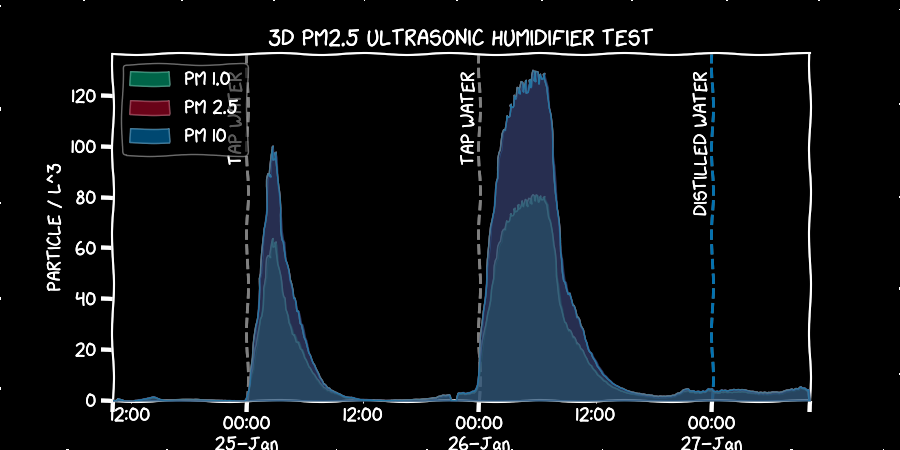PM2.5 and Air Quality
Introduction
I acquired a fine particulate matter sensor (PM2.5) which detects particles in the air which are 1-10 microns in size. These are much smaller than dust, pollen, and other typical allergens. Getting this was mostly for fun, but quickly became one of the more interesting devices to detect things. Indoor air pollution was generally quite good until I would see spikes and try to find the causes.
PM2.5 source investigations
Candle
The first test was to burn a candle nearby. This wasn't too detectable until you blow it out and the smoke causes a very distinct spike as it dissipates.
Cooking
Cooking became the next activity in the spotlight. With the sensor in a different part of the house, the levels would rise more gradually, then decline as the meal completed. The biggest culprit was naturally the stove top, especially if anything smoked or burned. The oven is also detectable if run for longer periods.
Using the ventilating hood and air circulation is quite important for reducing the PM2.5 while cooking.
Burning
Later as the seasons changed, I noticed a few anomalous nights of unusually high persistent values. Some chasing of this eventually led to a correlation with fireplace usage in the neighborhood.
HVAC
Other anomalies began to creep in as well, the baseline no longer persisted around 0 and the air filter would click on more often. This anomaly would eventually be defined by very pleasant temperatures where no HVAC was needed. The air circulation and filtration from a HVAC system is quite beneficial.
Ultrasonic Humidifiers
A very significant anomaly crept in with some extreme cold as well. The PM2.5 rose to over 100, then persisted at that level for days. This is the kind of value I would expect in a wildfire, not some cold evening. There was a long investigation with interrogations on the usage of firewood and the safety of gas heating systems. Eventually the outdoor humidity rose so I turned off the ultrasonic humidifier in a bedroom and noticed later that the PM2.5 slowly fell.
Now that I know the source is the ultrasonic humidifier, why? - Is the device dirty? - Is the water too hard? - Is the PM2.5 just water droplets? I am measuring particles the air with this sensor, not their mass or anything that might indicate what they may be.
The first humidifier test was easy, serious cleaning with bleach and allow to dry before refilling with tap water and starting again. This test failed and value was the same, any theories of a biological source were greatly discounted. The weather returned to a more humid normal and testing was paused.
The later test came during another period of extremely low indoor humidity. Tap water was used for a couple of nights as a baseline. Then the third night used distilled water which was a success. The PM2.5 remained quite low throughout the night while the ultrasonic humidifier was running. The first night ran the humidifier for 4-5 hours but the subsequent two tests were for at least 7 hours.

This leads to the same conclusion found elsewhere, the minerals in the tap water are the source of PM2.5 and not water droplets. From now, I'll only use distilled water in an ultrasonic humidifier and strongly recommend others do the same.